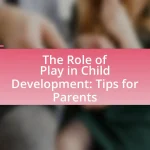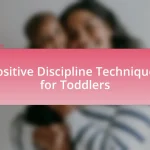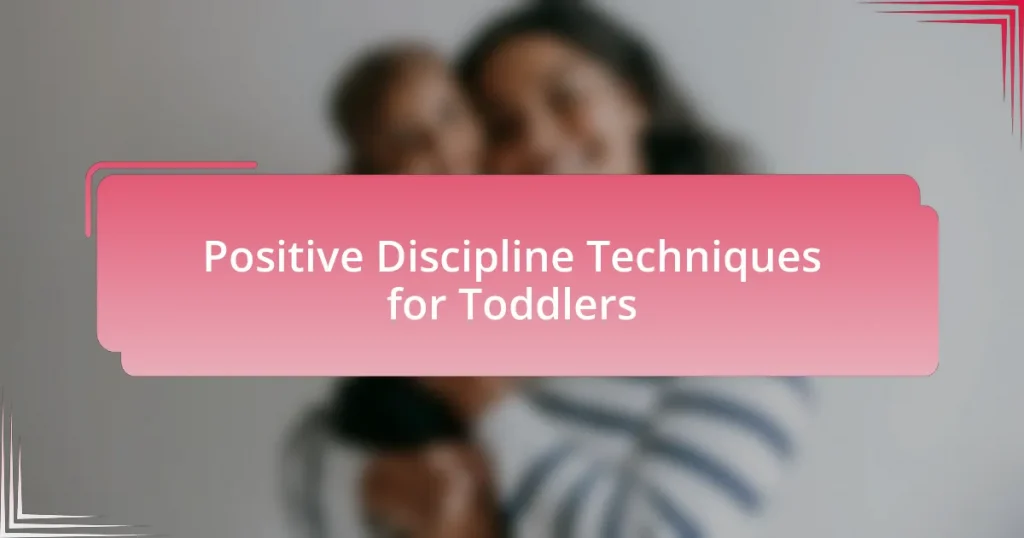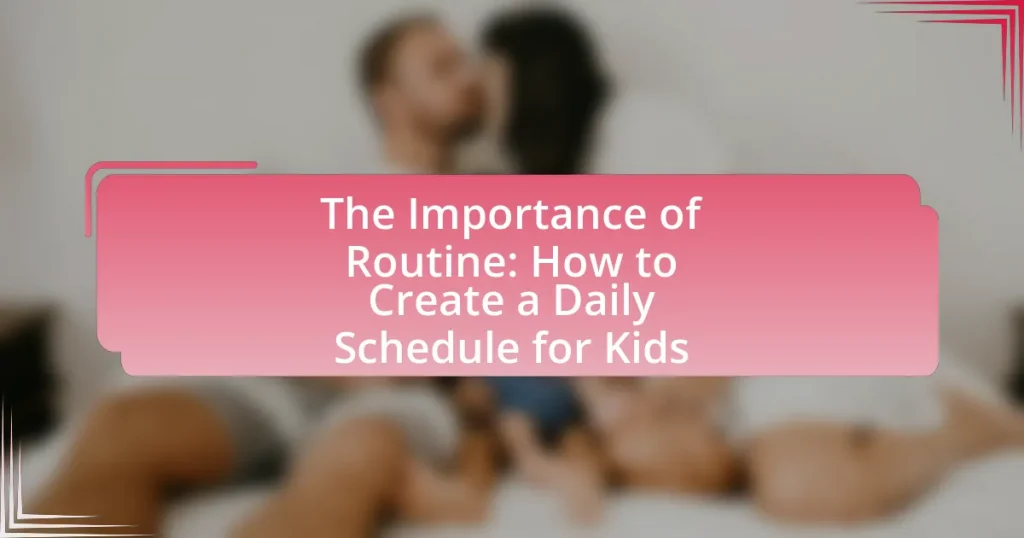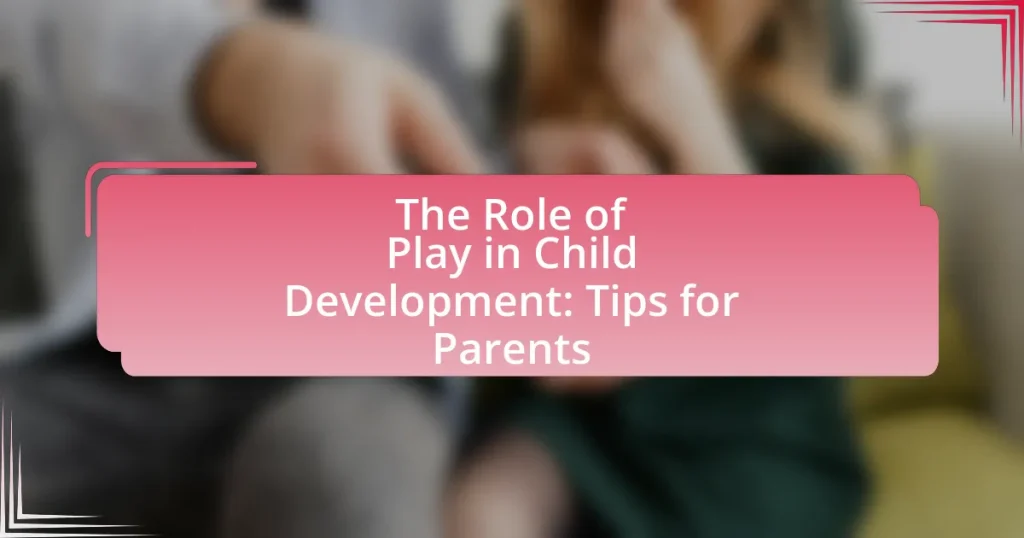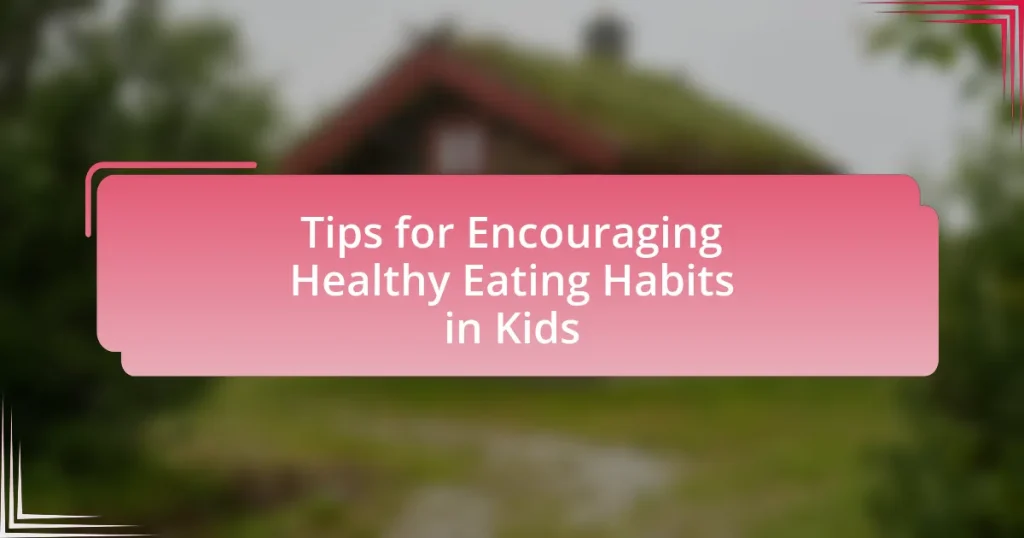Positive Discipline Techniques for toddlers are strategies designed to promote learning, self-regulation, and emotional development in a nurturing environment. These techniques emphasize positive reinforcement, clear expectations, and natural consequences, contrasting with traditional discipline methods that often rely on punishment. Key components include mutual respect, understanding developmental stages, and effective communication, all aimed at fostering cooperation and problem-solving skills. Research supports that implementing these techniques leads to better emotional regulation, social skills, and stronger parent-child relationships, ultimately nurturing well-adjusted and resilient toddlers.
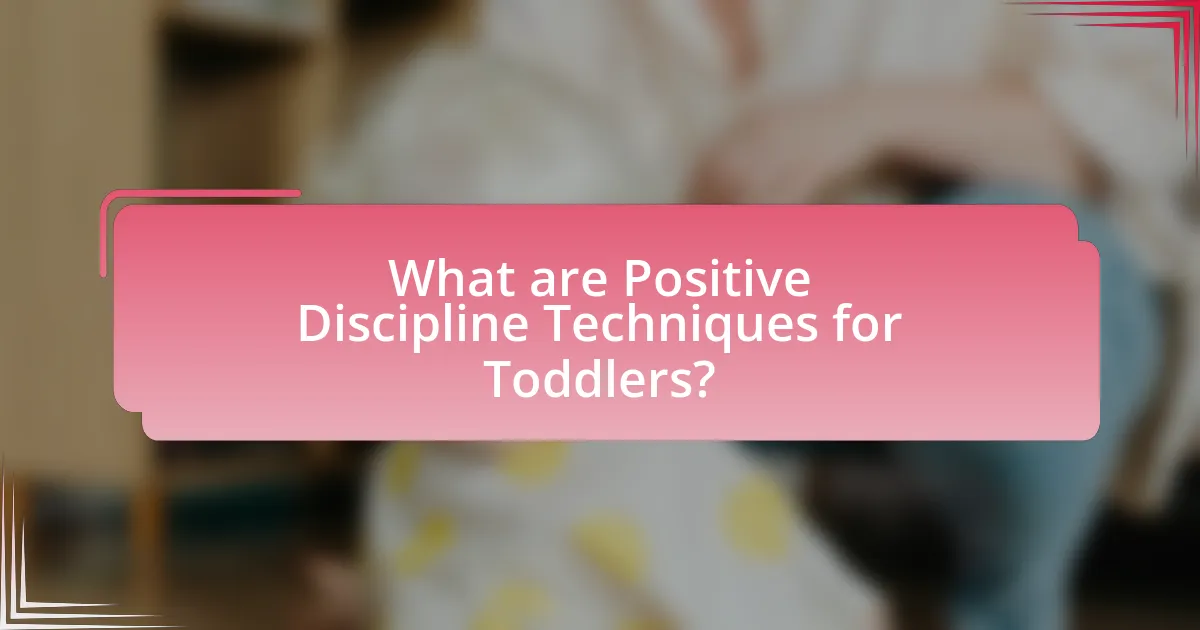
What are Positive Discipline Techniques for Toddlers?
Positive discipline techniques for toddlers include strategies that promote learning and self-regulation while maintaining a nurturing environment. These techniques focus on guiding behavior through positive reinforcement, setting clear expectations, and using natural consequences. For example, praising toddlers for good behavior encourages them to repeat those actions, while offering choices empowers them and fosters independence. Research indicates that positive discipline can lead to better emotional and social outcomes for children, as it helps them develop problem-solving skills and understand the impact of their actions.
How do Positive Discipline Techniques differ from traditional discipline methods?
Positive Discipline Techniques focus on teaching children self-discipline and problem-solving skills, while traditional discipline methods often rely on punishment and control. Positive Discipline emphasizes understanding the child’s perspective and fostering a supportive environment, which contrasts with traditional methods that may prioritize obedience through fear or consequences. Research indicates that Positive Discipline can lead to better emotional regulation and social skills in children, as it encourages cooperation and mutual respect rather than compliance through fear.
What principles underpin Positive Discipline Techniques?
Positive Discipline Techniques are underpinned by principles that emphasize respect, empathy, and the importance of teaching children self-discipline. These techniques focus on fostering a positive relationship between adults and children, encouraging cooperation rather than punishment. Research indicates that Positive Discipline is rooted in the understanding that children learn best in an environment that is supportive and nurturing, which promotes their emotional and social development. Additionally, these techniques advocate for setting clear expectations and consequences, helping children understand the impact of their behavior while maintaining their dignity.
Why is it important to use Positive Discipline Techniques with toddlers?
Using Positive Discipline Techniques with toddlers is important because they promote healthy emotional and social development. These techniques help toddlers learn self-regulation, empathy, and problem-solving skills, which are crucial for their growth. Research indicates that positive discipline fosters a secure attachment between caregivers and children, leading to better behavioral outcomes. For instance, a study published in the Journal of Family Psychology found that children who experienced positive discipline were less likely to exhibit behavioral problems and more likely to develop positive social skills. Therefore, implementing these techniques is essential for nurturing well-adjusted and resilient toddlers.
What are the key components of Positive Discipline Techniques?
The key components of Positive Discipline Techniques include mutual respect, understanding the child’s developmental stage, and teaching valuable life skills. Mutual respect fosters a positive relationship between the caregiver and the child, promoting cooperation and communication. Understanding the child’s developmental stage allows caregivers to set appropriate expectations and responses, ensuring that discipline is age-appropriate and effective. Teaching valuable life skills equips children with the tools they need to navigate challenges and make responsible choices, ultimately leading to better behavior and self-regulation. These components are supported by research indicating that positive reinforcement and guidance lead to more effective discipline outcomes compared to punitive measures.
How can communication be effectively used in Positive Discipline?
Effective communication in Positive Discipline involves using clear, respectful language to convey expectations and consequences. This approach fosters understanding and cooperation between caregivers and toddlers, promoting a supportive environment. Research indicates that positive communication techniques, such as active listening and using “I” statements, enhance emotional connection and reduce resistance in children. For example, stating “I feel upset when toys are thrown” helps toddlers understand the impact of their actions, encouraging them to reflect on their behavior. This method aligns with the principles of Positive Discipline, which emphasize teaching rather than punishing, ultimately leading to better behavioral outcomes.
What role does consistency play in Positive Discipline Techniques?
Consistency is crucial in Positive Discipline Techniques as it establishes clear expectations and boundaries for toddlers. When caregivers consistently apply rules and consequences, children learn to understand the relationship between their behavior and the outcomes, which fosters a sense of security and predictability. Research indicates that consistent discipline leads to better behavioral outcomes in children, as it reinforces learning and helps them internalize appropriate behaviors. For instance, a study published in the Journal of Family Psychology found that consistent parenting practices are linked to improved emotional regulation and social competence in children.
What are some common Positive Discipline Techniques for toddlers?
Common Positive Discipline Techniques for toddlers include setting clear expectations, using time-outs, offering choices, and employing positive reinforcement. Setting clear expectations helps toddlers understand acceptable behavior, while time-outs provide a moment for reflection. Offering choices empowers toddlers and encourages decision-making, and positive reinforcement, such as praise or rewards, reinforces desired behaviors. Research indicates that these techniques promote emotional regulation and social skills in young children, supporting their overall development.
How can time-outs be used positively?
Time-outs can be used positively by providing children with a structured opportunity to calm down and reflect on their behavior. This technique allows toddlers to step away from a situation that may be overwhelming or emotionally charged, helping them regain self-control. Research indicates that when implemented correctly, time-outs can reinforce appropriate behavior by giving children a moment to process their actions and understand the consequences. For instance, a study published in the Journal of Child Psychology and Psychiatry found that time-outs, when used as a consistent disciplinary method, can lead to improved emotional regulation in children.
What is the significance of setting clear expectations?
Setting clear expectations is significant because it provides a framework for behavior, helping toddlers understand what is acceptable and what is not. This clarity reduces confusion and anxiety, enabling children to navigate their environment more effectively. Research indicates that when caregivers articulate specific expectations, children are more likely to exhibit desired behaviors, as they feel secure and understand the boundaries set for them. For instance, a study published in the Journal of Applied Developmental Psychology found that children who received consistent and clear guidelines from parents demonstrated improved self-regulation and compliance.
How can positive reinforcement be effectively applied?
Positive reinforcement can be effectively applied by consistently rewarding desired behaviors to encourage their repetition. For instance, when a toddler shares toys with peers, providing verbal praise or a small reward reinforces that behavior, making it more likely to occur again. Research indicates that positive reinforcement increases the likelihood of desired behaviors; a study published in the Journal of Applied Behavior Analysis found that children who received immediate praise for positive actions showed a significant increase in those behaviors over time.
How can parents implement Positive Discipline Techniques at home?
Parents can implement Positive Discipline Techniques at home by establishing clear expectations and consistent consequences for behavior. This involves setting specific rules that are communicated clearly to toddlers, ensuring they understand what is expected of them. For instance, parents can use positive reinforcement, such as praise or rewards, to encourage desirable behaviors, while calmly explaining the reasons behind any consequences for undesirable actions. Research indicates that consistent application of these techniques fosters a sense of security and understanding in children, which can lead to improved behavior over time. Additionally, parents can model appropriate behavior themselves, as children often learn by observing their caregivers.
What strategies can parents use to stay calm during challenging situations?
Parents can use deep breathing techniques to stay calm during challenging situations. This method involves taking slow, deep breaths to reduce stress and regain composure. Research indicates that deep breathing activates the body’s relaxation response, which can lower heart rate and decrease anxiety levels. Additionally, parents can practice mindfulness by focusing on the present moment, which helps in managing overwhelming emotions. Studies show that mindfulness can improve emotional regulation and reduce reactivity in stressful situations. Another effective strategy is to take a brief timeout, allowing parents to step away and collect their thoughts before responding. This approach can prevent impulsive reactions and promote thoughtful communication.
How can parents model appropriate behavior for their toddlers?
Parents can model appropriate behavior for their toddlers by consistently demonstrating positive actions and responses in everyday situations. For instance, when parents express kindness, patience, and respect in their interactions, toddlers are likely to imitate these behaviors. Research indicates that children learn through observation; a study published in the journal “Child Development” found that children who observe positive social interactions are more likely to engage in similar behaviors themselves. By using clear communication, showing empathy, and practicing problem-solving in front of their toddlers, parents reinforce the importance of these behaviors, thereby fostering a positive environment for learning and development.
What challenges might parents face when using Positive Discipline Techniques?
Parents may face several challenges when using Positive Discipline Techniques, including inconsistency in application, difficulty in maintaining patience, and resistance from children. Inconsistency can arise when parents do not uniformly apply the techniques, leading to confusion for the child about expectations and consequences. Maintaining patience is crucial, as Positive Discipline requires time and emotional regulation, which can be difficult during stressful situations. Additionally, children may resist these techniques, especially if they are accustomed to more traditional forms of discipline, making it challenging for parents to implement these strategies effectively. Research indicates that consistent application of Positive Discipline can lead to better behavioral outcomes, but the initial resistance and emotional demands can hinder its effectiveness.
How can parents overcome resistance from toddlers?
Parents can overcome resistance from toddlers by using positive reinforcement and offering choices. Positive reinforcement encourages desired behaviors by rewarding toddlers when they comply, which can lead to increased cooperation. For example, praising a toddler for putting away toys can motivate them to repeat that behavior. Offering choices empowers toddlers, making them feel in control; for instance, allowing them to choose between two outfits can reduce resistance during dressing. Research indicates that these techniques can effectively reduce defiance and promote compliance in young children, as they foster a sense of autonomy while maintaining parental guidance.
What should parents do if they feel overwhelmed by the process?
Parents should seek support and take breaks if they feel overwhelmed by the process of positive discipline for toddlers. Engaging with a support network, such as family, friends, or parenting groups, can provide emotional relief and practical advice. Research indicates that parents who share their experiences and challenges with others report lower stress levels and improved coping strategies. Additionally, taking short breaks allows parents to recharge, which can enhance their ability to implement positive discipline techniques effectively.
What are the long-term benefits of using Positive Discipline Techniques?
The long-term benefits of using Positive Discipline Techniques include improved emotional regulation, enhanced problem-solving skills, and stronger parent-child relationships. Research indicates that children who experience positive discipline are more likely to develop self-discipline and empathy, leading to better social interactions and academic success. A study published in the Journal of Family Psychology found that children raised with positive discipline techniques showed lower levels of aggression and higher levels of cooperation by the age of 10, demonstrating the lasting impact of these methods on behavior and interpersonal skills.
How do Positive Discipline Techniques contribute to a toddler’s emotional development?
Positive Discipline Techniques significantly enhance a toddler’s emotional development by fostering self-regulation and empathy. These techniques emphasize understanding and respect, which help toddlers learn to manage their emotions and respond to others’ feelings. Research indicates that when caregivers use positive discipline, such as setting clear expectations and providing consistent consequences, toddlers develop better emotional intelligence. A study published in the Journal of Family Psychology found that children exposed to positive discipline strategies exhibited higher levels of emotional competence and social skills compared to those who experienced punitive measures. This evidence supports the notion that Positive Discipline Techniques are effective in nurturing a toddler’s emotional growth.
What impact do these techniques have on parent-child relationships?
Positive discipline techniques significantly enhance parent-child relationships by fostering mutual respect and understanding. These techniques encourage open communication, allowing children to express their feelings and thoughts, which strengthens emotional bonds. Research indicates that when parents employ positive discipline, children exhibit increased cooperation and reduced behavioral issues, leading to a more harmonious family environment. For instance, a study published in the Journal of Family Psychology found that parents who practiced positive discipline reported higher levels of satisfaction in their relationships with their children, highlighting the effectiveness of these techniques in promoting healthy interactions.
What practical tips can enhance the effectiveness of Positive Discipline Techniques?
To enhance the effectiveness of Positive Discipline Techniques, parents should establish clear expectations and consistent consequences. Clear communication helps toddlers understand acceptable behaviors, while consistency reinforces those expectations, making it easier for children to learn from their actions. Research indicates that children respond better to discipline when they know what is expected of them and the consequences of their behavior, as highlighted in the book “Positive Discipline” by Jane Nelsen, which emphasizes the importance of structure and support in child development.

